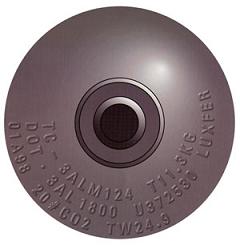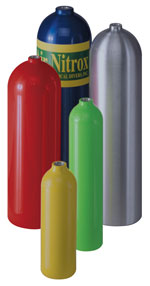|
How to buy used SCUBA TanksPurchasing used scuba tanks can be a challenge. We have outlined a few guidelines to consider before you buy. Step one is to review the external markings on the tank. It is these marking that will aid you in determining: 
• Last Hydrostatic test date • The type of scuba tank • The manufacture of the Scuba tank • Whether or not the scuba tank can be used in the United States • The type of material the scuba tank is made of • The capacity of the scuba tank
If you do buy a used scuba tank, always get the tank hydrostatic tested, regardless on its last test. The reason is simple. You do not know if the tank was dropped or exposed to an excessive amount of heat. Both of these incidents could cause a scuba tank to fail. Since you do not know he condition of the tank valve or if any contamination has occurred, get the valve rebuilt. Now, do the math: • $30 for a new hydrostatic test • $20 for a valve rebuild Even if both the valve and tank hydrostatic test pass, you could easily be at $90 - $100 for everything. A new tank cost only $120. 
Steel scuba tanks do not usually fail hydrostatic testing, but usually fail a visual test. The cause for a steel scuba tank to not pass is rust on the inside of the tank. It does not take much water vapor to start the rust process. Water vapor usually gets into a tank through the filling process. A little bit of water on the value and a filling station operator is not paying attention, will cause this water to get forced into the tank by the air compressor. Some tanks are not worth buying at any time: • If the tank does not have the DOT/CTC stamp. Military and European tanks cannot be filled in the United States by commercial scuba shops. • Any tank from Walter Kidde (Alloy 6351) • Luxfer USA manufactured cylinders from 6351-alloy from 1972 through mid-1988 Special note on aluminum alloy 6351. While less than ½% of these tanks have exhibited Sustained Load Cracking (SLC), most dive shops prefer to stay clear of them. Each year there seems to be one or two additional reports of catastrophic (explosion) failure.
|
